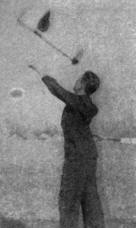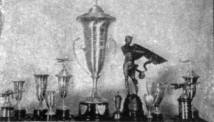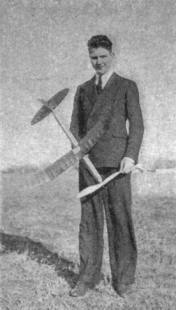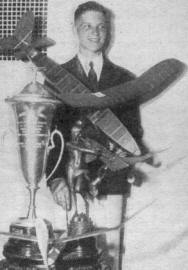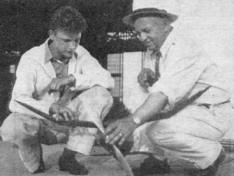|
The Mulvihill Complete plans for duplicating another N.A.A. record
holder By Alvie Dague In collaboration with Gordon S. Light
ABOUT 2:30 in the afternoon of July 8th, Bruce Luckett and Alvie Dague, Jr., went "thermal hunting" on the Wayne County Airport near Detroit. It was the day of the Mulvihill Trophy contest and these two modelers from Tulsa, Oklahoma, were determined to keep the Mulvihill Trophy in their city -- where it had spent the past year by virtue of Luckett's Mulvihill victory the year before. Their search finally narrowed down to a point near one of the diagonal concrete runways. They decided the models would drift over a large portion of the hot runway during their flights. Dague was the first to fly. It took considerable courage on his part to pack 560 turns into the rubber motor, since he had already ruined one stick model earlier in the day when the rubber broke. The model went into a fast right-spiral climb and had gained considerable altitude by the time it began to hit "bumps" over the runway. The model drifted across the road and over a wheat field before it began to hit any real risers. And then a few minutes later it was a tiny speck under the big cumulus clouds. The red covering of the wing and tail helped keep the model in sight. Sun flashes on the polished propeller and motor tube prevented losing the model before it had made good time. Another Tulsan, Dewitt Ross, followed the model in his car. There were five persons in the car watching the model. Nevertheless, the chase ended after 33 minutes and 2 seconds when the model flew into a cumulus cloud. Dague's time was about 10 minutes ahead of his nearest rival -- the Mulvihill Trophy would spend another year in Tulsa! Luckett didn't mind losing the trophy to his fellow club member. The best he was able to do was to take 5th. Alvie credits this model as being the best outdoor flying model he ever built. This fact is especially impressive in view of Dague's long list of contest-winning models. This model was built in November, 1936 and turned in a few flights under the old weight rule. When the new weight rule of 3 ounces per 100 square inches went into effect, the only change necessary was the addition of extra strands of rubber to bring the model up to weight. The flight of the model was not handicapped by the increased weight. At a local contest in Tulsa, the model turned in the fastest and steepest climb. Its performance was more impressive than the old weight rule models. The glide was not quite satisfactory requiring further adjustment. Otherwise the flight was practically perfect. The improved performance of the model was the result of decrease in drag through cleaner design, combined with greater power. The inclosed motor and the elimination of the landing gear reduced the drag. The propeller had a 22-1/2 -- inch pitch, 15 inches diameter, and a small amount of blade area. Driven by 24 strands of rubber, the propeller would give the model a startling burst of speed at the beginning of the flight. After playing with the model for some time, Dague tried to convert its pep into good endurance flying. With a little persuasion, the glide was changed from a rather steep angle into a nice powerless flight with 50-foot right circles. The improved glide, together with several other minor adjustments, had changed this "frivolous" model into an endurance job that was consistently turning in flights of better than three minutes. The increased wing loading had not decreased model performance in any way. By the time of the National contest last July, Dague had done considerable flying with this model. And it was only natural he should hopefully turn to this old-faithful job after breaking his new stick model the morning of the Mulvihill contest. And it came through with a spectacular performance. This model was the 7th of a series of outdoor stick models Dague has designed and built since the spring of 1935. Charles Stewart and Dague were the first Tulsans to really develop the outdoor stick job. Together they promoted the use of the triangular motor stick and the motor-stick-saddle wing mount. At a contest in Tulsa on Easter Sunday in 1935, Dague's first stick model took 1st with 21 minutes. He used the same model in the 1935 Mulvihill contest at St. Louis, taking 5th with an out-of-sight flight of 8:43. He built his second stick model immediately after this contest. It disappeared on a test flight after 10 minutes. Dague's third stick model really did some important flying -- 7 minutes in the first test flight; 21 minutes at the Tulsa State Fair contest for a new Junior N.A.A. record; and finally out of sight a few weeks later after 14 minutes. All these early models used a triangular stick with the rubber hung below it. His next model carried the motor inside a tube and proved even better than the earlier designs. This model flew out of sight before Dague had an opportunity to enter it in any contests. It disappeared after 11 minutes on a cold, windy, winter day. The next stick model was also an inclosed motor design that won the Texas Centennial Contest in Dallas with 6:20. His next model was a return to the triangular motor stick. It took 2nd in the 1936 Mulvihill contest. This model met a rather inglorious end -- caught high in the trees while a brisk November wind battered it to pieces. Dague's seventh stick model -- the 1937 Mulvihill winner -- flew out of sight on the winning flight. Of his seven stick models, all except one flew out of sight on thermals. Polyhedral wings is an outstanding characteristic of Dague's designs. This feature seems to be particularly suited to high-powered flight. This type wing helps provide the spiral stability which is very important in a high-powered stick model. Because of the short duration, every second of the power-run must be spent in climbing to get sufficient duration for a long flight. The model must be stable in every respect or the speed necessary for a fast climb can prove quite disastrous. A well-adjusted model can be launched in a nearly vertical position and it will spiral straight up for about 20 or 25 seconds. During the remainder of the power flight it will continue to climb at a steep angle. The usual propeller duration with maximum winds is about 40-50 seconds. The best adjustments which Dague has discovered is 4 degrees positive incidence in the wing. This angle is measured relative to the actual thrust line and not the motor stick. About 1 degree positive incidence is used in the elevator. Some models require more "down-thrust" than others. This adjustment would necessarily increase the effective incidence of the wing. However, the difference in incidence between the wing and the elevator should always remain the same -- about 3 degrees. Dague makes all his adjustments on the noseplug of the model after the wing has been adjusted for the best possible glide. By varying the amounts of down and right-thrust he can control the power flight without impairing the flat glide. The elevator is mounted permanently at an angle of zero degrees with the center line of the tube and tail boom. The wing is given an angle of three degrees as measured from the center line of the tube. The prop is offset at least one degree negative with the center of the tube. Therefore, the resulting incidence of the wing is four degrees, the elevator one degree. He usually estimates the amount of down and right-thrust when cutting the noseplug of the model. But invariably this adjustment has to be corrected when the model is actually flown. CONSTRUCTION NOTES Construction of the Mulvihill Winner is clear from the drawings. Simplicity is the keynote of the design and beginners should have little trouble duplicating this model. Power -- use 24 strands of 1/8 x 1/30" brown rubber, 24" long. Propeller - -cut from hard balsa. Add 1/8 to 3/16" camber in the rear face of the blade. After smoothing with rough sandpaper, polish the propeller with 10-0 sandpaper with intermittent coats of dope. The finished propeller should have a high gloss. Metal propeller guards are cut from tin-can metal. Rudder -- the airfoil is flat. Do not attach the rear portion of the rudder to the tail boom. Change the rudder setting by warping the rear rudder. Don't water dope the tissue on the rudder. If the tissue is stretched too tightly, it will distort the shape. Wing-Saddle -- rests flat atop the motor tube. Cement two pieces of tough 1/16" sheet to form a V. Attach the .045 wire clips to this V with cement. Insert the other ends of the clips into the leading and trailing edges of the wing. The wing saddle is permanently attached to the wing. Assembly -- hold the wing, tail boom, and nose block in position with rubber bands. The elevator is firmly cemented to the tail boom. The rudder is attached to the top of the elevator. Reinforce the rudder with a light bamboo strut, extending from the leading edge of the elevator to the leading edge of the rudder. The Mulvihill Winner is an interesting design. It will be interesting to learn about the flights that it turns in. Write and tell us about your version of this contest winner. Dague will give you the benefit of his three years' experience with this type model by advising us on the answers to any questions which might arise. Scanned From February 1938 |
